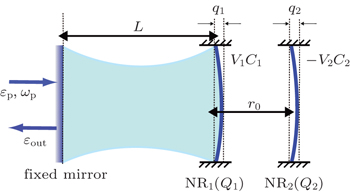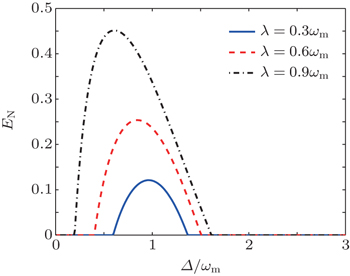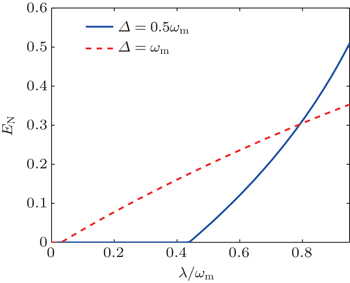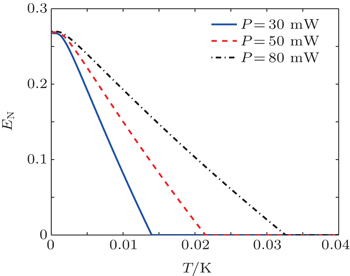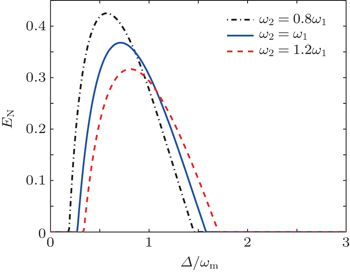† Corresponding author. E-mail:
Project supported by the Major Research Plan of the National Natural Science Foundation of China (Grant No. 91121023), the National Natural Science Foundation of China (Grant Nos. 61378012, 60978009, and 11574092), the Specialized Research Fund for the Doctoral Program of Higher Education of China (Grant No. 20124407110009), the National Basic Research Program of China (Grant Nos. 2011CBA00200 and 2013CB921804), and the Program for Changjiang Scholar and Innovative Research Team in University, China (Grant No. IRT1243).
We propose a scheme for entangling two nanomechanical oscillators by Coulomb interaction in an optomechanical system. We find that the steady-state entanglement of two charged nanomechanical oscillators can be obtained when the coupling between them is stronger than a critical value which relies on the detuning. Remarkably, the degree of entanglement can be controlled by the Coulomb interaction and the frequencies of the two charged oscillators.
Cavity optomechanics has sparked the interest of a vast scientific community over the past few years due to its distinct applications, such as the high-sensitivity detection of tiny mass, force, and displacement. [ 1 – 4 ] In a typical optomechanical system, a movable mirror couples the cavity field by the radiation pressure, and this coupling can lead to many remarkable effects, for example, the optomechanically induced transparency (OMIT), [ 5 – 11 ] the quantum ground state cooling of the nanomechanical oscillators, [ 12 , 13 ] the entanglement between cavity modes and/or mechanical modes, [ 14 – 23 ] and the squeezed states of light or mechanical modes. [ 24 – 26 ]
Entanglement is one of the most striking properties of quantum mechanics and has become a significant resource for quantum information processing. Although quantum mechanics has been proven to be highly successful in explaining physics at microscopic and subatomic scales, its validity at macroscopic scales is still debated. Over recent decades, thanks to the theoretical study and technological progress, it has now been possible to obtain entanglement in mesoscopic and even macroscopic systems. In addition to the theoretical proposals [ 14 – 17 ] that predict entanglement between a mechanical oscillator and a cavity field, the recent experimental realization [ 18 ] of entanglement between the motion of a mechanical oscillator and a propagating microwave in an electromechanical circuit makes optomechanical system a promising platform for generating macroscopic entanglement. Moreover, entanglement between mechanical oscillators can also be obtained by use of the squeezed input optical field, [ 27 – 29 ] the cascaded cavity coupling, [ 30 ] and the conditional quantum measurements. [ 31 , 32 ] In fact, entangled optomechanical systems have potential profitable application in realizing quantum communication networks, in which the mechanical modes play the vital role of local nodes where quantum information can be stored and retrieved, and optical modes carry the information between the nodes. This allows the implementation of CV quantum teleportation, [ 33 , 34 ] quantum telecloning, [ 35 ] and entanglement swapping. [ 36 ]
In this work, we investigate the entanglement in an optomechanical cavity coupled to an external nanomechanical oscillator (NMO) via Coulomb interaction. Using logarithmic negatively as an entanglement measure, we show that the two charged NMOs are entangled in the steady state through introducing the Coulomb coupling. The generated NMO–NMO entanglement is strongly dependent on the Coulomb coupling strength and the frequencies of the two charged mirrors. In addition, we also show the robustness of the entanglement to temperature at different pump power.
Different from the conventional optomechanical systems [ 37 , 38 ] where the entanglement between two movable mechanical oscillators is generated by the inner cavity modes or induced by the external atoms, the entanglement between the two charged NMOs in our scheme is created by Coulomb interaction. Moreover, compared with the conventional methods, the Coulomb coupling has important advantages, for example, the range of the interaction distance is from nanometer to meter, [ 39 , 40 ] the strength can be controlled by the bias voltage, [ 41 ] and it can also be applied to couple different kinds of charged objects at different frequencies. [ 42 ]
The rest of this paper is organized as follows. In Section 2, we present the model under study and the analytical expressions of the optomechanical system, and derive the quantum Langevin equations and the steady state of the system. In Section 3, we quantify the entanglement properties of the two charged NMOs by using the logarithmic negativity. Finally we draw our conclusions in Section 4.
As sketched in Fig.




Considering photon losses from the cavity and the Brownian noise from the environment, we may describe the dynamics of the system governed by Eq. (




From the Langevin equations above, we can obtain the steady-state mean-values as
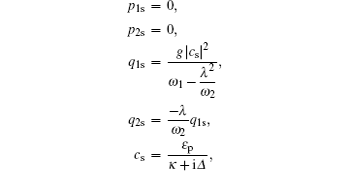
We can rewrite each Heisenberg operator as its steady-state mean-value plus an additional fluctuation operator with zero-mean value, c = c s + δc , q i = q i s + δq i , p i = p i s + δp i ( i = 1,2). For generating optomechanical entanglement the input power is usually very large, which means | c s | ≫ 1, so we can ignore some small quantity and get the linearized Langevin equations


In this section, we study the NMO–NMO entanglement and analyze how the degree of entanglement depends on the Coulomb interaction and the frequencies of the two charged NMOs. We also investigate the robustness of the entanglement against temperature.
In order to investigate the optomechanical entanglement, it is more convenient to use the quadratures operators defined by 







The solution of Eq. (



Now, we examine the NMO–NMO entanglement of this optomechanical system. For this purpose, we consider the entanglement of the bipartite subsystems that can be traced over the remaining degrees of freedom. This bipartite entanglement will be quantified by using the logarithmic negativity



For simplicity, we choose all the parameters of the two charged NMOs to be the same, i.e., ω 1 = ω 2 = ω m , γ 1 = γ 2 = γ m . In order to obtain a significant amount of entanglement, we have made a careful analysis in a wide parameter range and found the system parameters, as shown in Table
| Table 1. The parameters used in our numerical calculations which are based on the experiment conditions. [ 49 , 50 ] . |
In Fig.
To further explore the effect of NMO–NMO coupling strength on the entanglement of the two charged NMOs, we plot in Fig.
Figure
In practice, it is hard to achieve two identical NMOs in experiments. For this reason, we plot in Fig.
In conclusion, we have analyzed the NMO–NMO entanglement in an optomechanical system with two charged NMOs. We show that due to the Coulomb interaction between the two NMOs, they can be entangled. We also find that the generated entanglement can be controlled by adjusting the Coulomb coupling strength and the frequencies of the two charged NMOs: i) The entanglement between the two charged NMOs is enhanced with increasing the Coulomb coupling strength λ . ii) The degree of NMO–NMO entanglement is increased when the frequency of NMO 2 is smaller than the frequency of NMO 1 ( ω 2 > ω 1 ), and is decreased when ω 2 < ω 1 . iii) The points for the optimal entanglement will be shifted to the left for ω 2 < ω 1 and to the right for ω 2 > ω 1 . Besides, we show that increasing the driving power leads to much more robust entanglement against temperature.
| 1 | |
| 2 | |
| 3 | |
| 4 | |
| 5 | |
| 6 | |
| 7 | |
| 8 | |
| 9 | |
| 10 | |
| 11 | |
| 12 | |
| 13 | |
| 14 | |
| 15 | |
| 16 | |
| 17 | |
| 18 | |
| 19 | |
| 20 | |
| 21 | |
| 22 | |
| 23 | |
| 24 | |
| 25 | |
| 26 | |
| 27 | |
| 28 | |
| 29 | |
| 30 | |
| 31 | |
| 32 | |
| 33 | |
| 34 | |
| 35 | |
| 36 | |
| 37 | |
| 38 | |
| 39 | |
| 40 | |
| 41 | |
| 42 | |
| 43 | |
| 44 | |
| 45 | |
| 46 | |
| 47 | |
| 48 | |
| 49 | |
| 50 |



